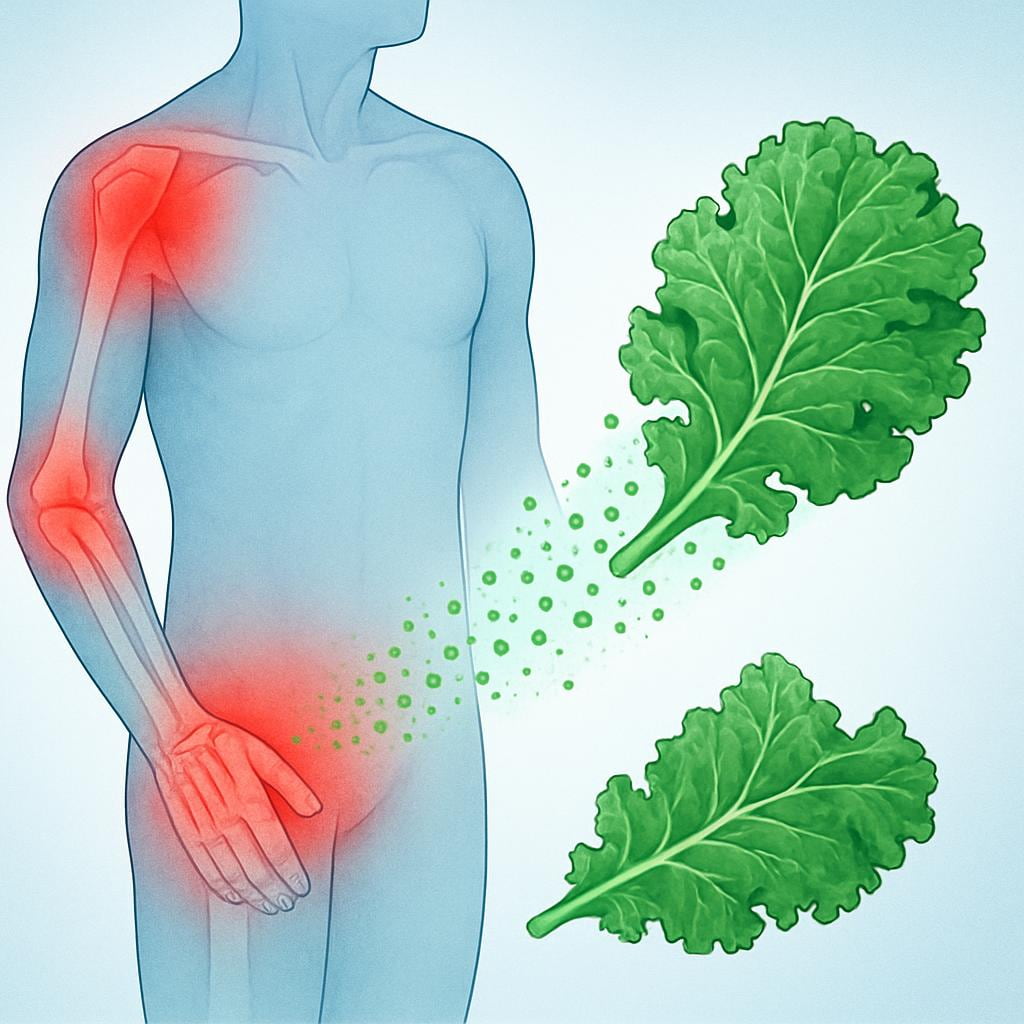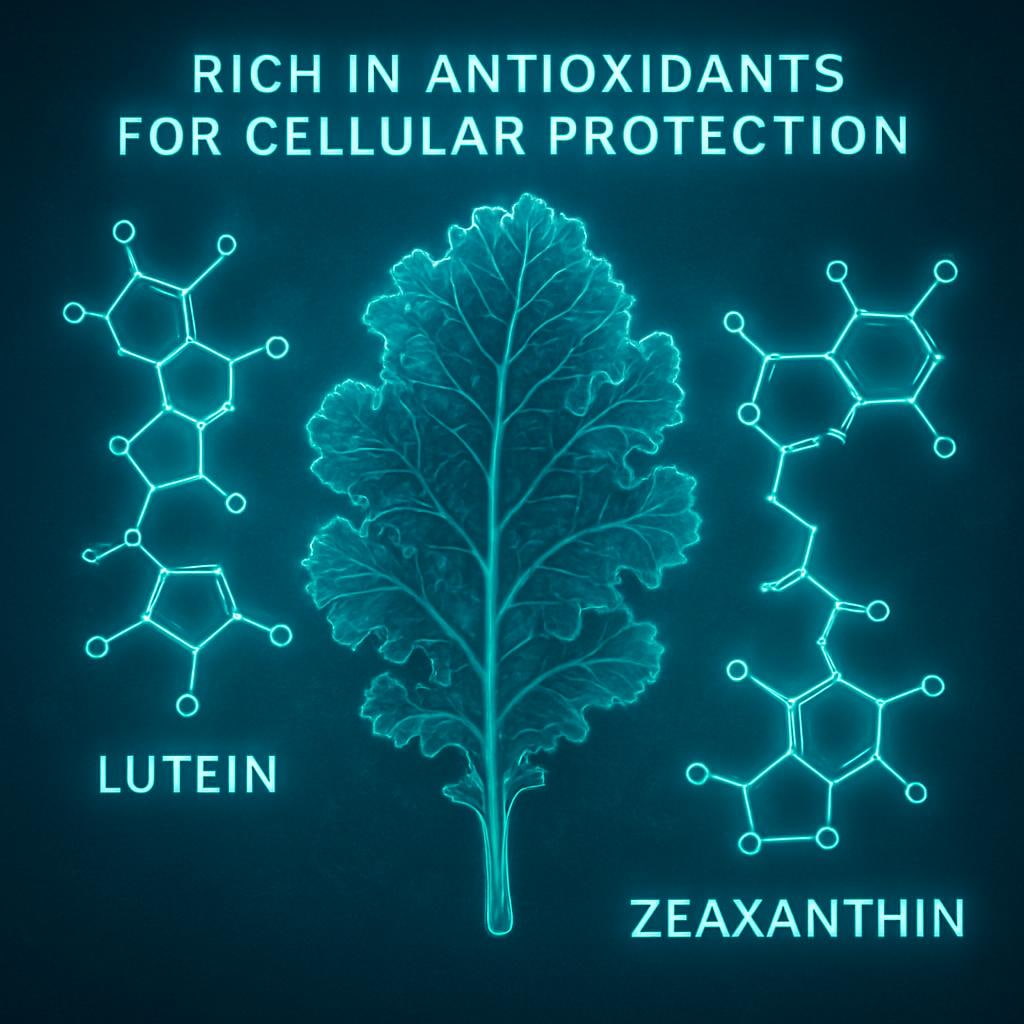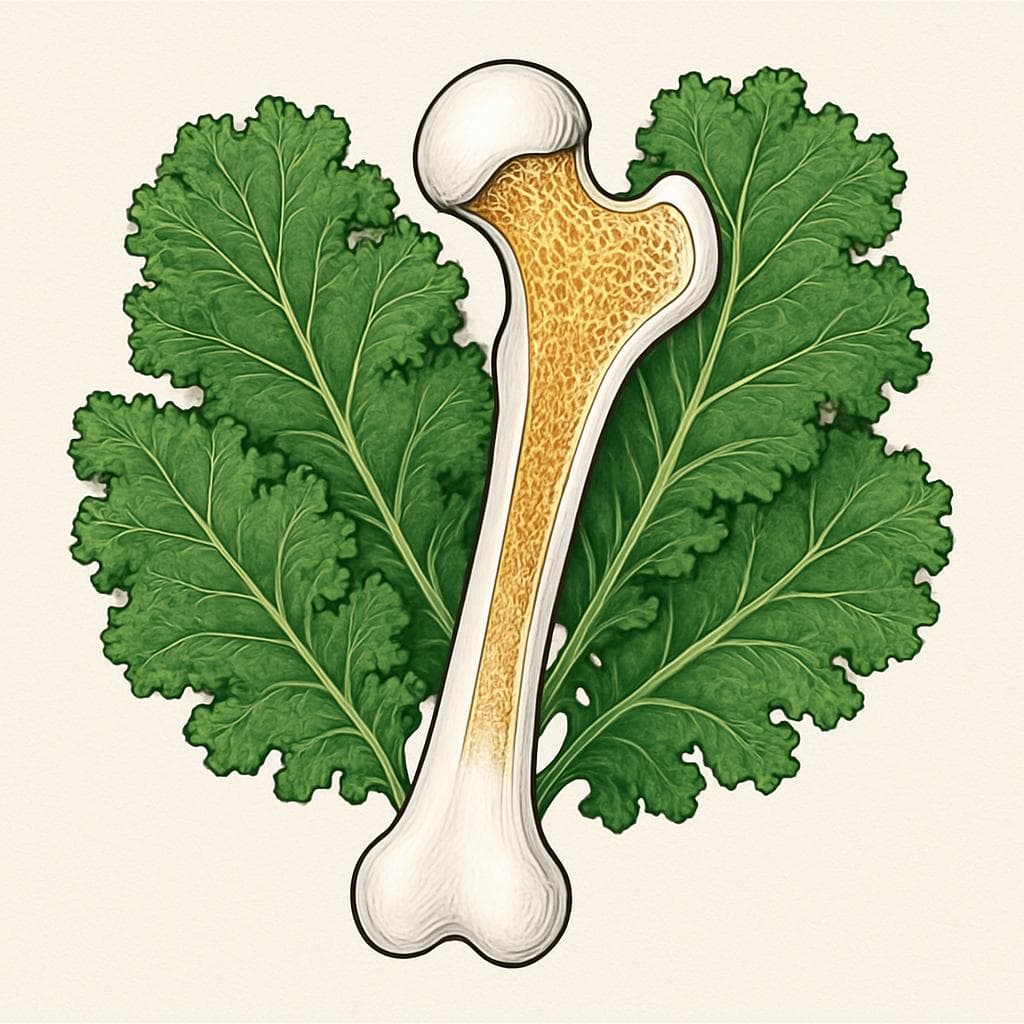Kale is one of the most nutrient-dense vegetables on the planet, and research shows it may support heart health, immunity, digestion, and overall wellness.
Packed with vitamins A, C, K, calcium, and powerful antioxidants, kale has earned its reputation as a superfood. Understanding its health benefits—and how to include it safely in your diet—can help you make smarter, evidence-based nutrition choices.

What Is Kale?
Kale (Brassica oleracea var. sabellica) is a leafy green vegetable in the cruciferous family, closely related to broccoli, cabbage, and Brussels sprouts.
It comes in several varieties, including curly kale, Lacinato (dinosaur) kale, and red Russian kale—each rich in fiber, chlorophyll, and plant compounds known as glucosinolates.
Kale’s combination of micronutrients and antioxidants makes it one of the most beneficial vegetables for daily wellness.

Nutritional Profile of Kale (Per 100 g, Raw)
Kale is one of the most nutrient-dense vegetables available, offering an exceptional range of vitamins, minerals, and antioxidants for very few calories. Its nutrient profile supports heart, bone, eye, and immune health — making it a cornerstone of many balanced diets.
According to the USDA FoodData Central (updated 2024), the following table outlines the key nutrients found in 100 grams of raw kale:
| Nutrient | Amount (per 100 g) | % Daily Value (%DV) | Key Functions |
|---|---|---|---|
| Calories | 35 kcal | — | Provides energy with low caloric density |
| Protein | 2.9 g | 6% | Supports muscle and tissue repair |
| Carbohydrates | 4.4 g | 2% | Provides slow-releasing energy |
| Dietary Fiber | 4.1 g | 16% | Promotes digestive health and satiety |
| Total Fat | 1.5 g | 2% | Contains healthy omega-3 (ALA) fats |
| Vitamin A (as Beta-Carotene) | 681 µg RAE | 76% | Supports vision, skin, and immune health |
| Vitamin C | 93 mg | 103% | Boosts immunity and collagen synthesis |
| Vitamin K | 389 µg | 324% | Essential for blood clotting and bone metabolism |
| Calcium | 254 mg | 20% | Supports bone strength and nerve function |
| Iron | 1.6 mg | 9% | Aids in oxygen transport and energy metabolism |
| Magnesium | 33 mg | 8% | Helps with muscle relaxation and energy production |
| Potassium | 348 mg | 7% | Regulates blood pressure and hydration |
| Folate (Vitamin B9) | 62 µg | 15% | Supports DNA synthesis and cell repair |
Source: USDA FoodData Central – Kale, Raw (FDC ID: 170379, accessed 2024)
Kale’s nutrient profile demonstrates why it’s often called a “superfood” — offering high micronutrient density per calorie.
Its particularly high vitamin K and vitamin C levels make it stand out among leafy greens, while the combination of fiber, calcium, and plant antioxidants contributes to many of the health benefits described in later sections.
10 Proven Health Benefits of Kale (Backed by Science)
Kale is among the most nutrient-dense foods available and may support heart, digestive, and immune health while contributing to overall vitality.
Below are 10 science-backed benefits explaining how this cruciferous green can enhance daily wellness when included as part of a balanced diet.
1. Supports Heart Health and Cholesterol Balance

Kale is rich in fiber, potassium, and powerful antioxidants such as quercetin and kaempferol that may support cardiovascular function.
A clinical study published in Nutrition Research (2012) found that men who drank kale juice daily for 12 weeks experienced higher HDL (“good”) cholesterol and reduced LDL oxidation—two markers linked with heart health improvement (PubMed – Nutrition Research, 2012).
How it helps:
- Fiber may help reduce LDL cholesterol absorption.
- Potassium supports healthy blood pressure levels, as noted by the American Heart Association.
- Antioxidants protect arteries from oxidative stress, helping maintain normal vascular function.
2. May Help Reduce Inflammation

Kale provides omega-3 alpha-linolenic acid (ALA) and polyphenols that may help balance the body’s inflammatory response. Chronic inflammation is linked with several health conditions, including cardiovascular disease and insulin resistance.
Research in Frontiers in Nutrition (2023) found that kale supplementation improved inflammatory markers and supported a more diverse gut microbiota in humans (Frontiers in Nutrition, 2023).
Key takeaway: Consistent intake of antioxidant-rich vegetables like kale may support natural anti-inflammatory processes, complementing overall metabolic health.
3. Promotes Digestive Health

With roughly 4 grams of dietary fiber per 100 grams, kale supports regular digestion and healthy bowel movements.
A 2023 human trial reported that daily kale intake increased stool frequency and fostered beneficial gut bacteria, including Bifidobacterium species, known for promoting gut balance (Frontiers in Nutrition, 2023).
Tip: Steam or lightly sauté kale to soften its fibrous texture and make nutrients easier to absorb while maintaining gut-friendly fiber content.
4. Supports Immune Function

Kale delivers a high concentration of vitamin C—about 93 mg per 100 g, exceeding 100 % of the daily value (USDA FoodData Central).
Vitamin C supports white blood cell function and skin barrier integrity, helping your immune system defend against environmental stressors (NIH ODS – Vitamin C Fact Sheet).
Additional immune-support nutrients in kale:
- Zinc (trace amounts) for immune signaling.
- Vitamin A to maintain mucosal tissue health.
- Polyphenols that act as natural antioxidants and may reduce oxidative burden.
5. Rich in Antioxidants for Cellular Protection

Kale is exceptionally rich in antioxidants, including lutein, zeaxanthin, beta-carotene, and flavonoids, which collectively help protect cells from oxidative stress—a key factor in aging and chronic disease development. These plant compounds support the body’s defense against free radicals that can damage tissues over time.
The carotenoids lutein and zeaxanthin, found abundantly in kale, are particularly important for eye health. They accumulate in the retina and macula, where they may help filter harmful blue light and support long-term visual performance.
According to Harvard Health Publishing – Top Foods to Help Protect Your Vision, diets rich in green leafy vegetables such as kale and spinach are associated with a lower risk of age-related macular degeneration (AMD) and other vision concerns.
In addition, kale’s beta-carotene (a precursor of vitamin A) and vitamin C support skin integrity, aiding natural collagen formation and protecting against environmental oxidative stress.
Regular inclusion of colorful vegetables like kale in a balanced diet may therefore support cellular health, vision maintenance, and skin vitality throughout aging.
6. May Support Healthy Blood Sugar Levels

Kale’s fiber and alpha-lipoic acid (ALA) may help support insulin sensitivity and stabilize post-meal blood sugar.
A 12-week randomized controlled study published in Nutrients (2024) reported that participants who consumed a kale-based nutrition bar had significantly lower HbA1c and improved insulin resistance (HOMA-IR) compared with the control group (MDPI – Nutrients, 2024).
Practical tip: Pair kale with whole grains or lean proteins to moderate glucose spikes and sustain energy levels throughout the day.
7. Supports Bone Strength and Density

Kale is one of the richest plant sources of calcium and vitamin K, both vital for bone metabolism. One cup of cooked kale offers about 20 % of the recommended calcium intake and more than 300 % of the vitamin K daily value.
The NIH Office of Dietary Supplements notes that adequate vitamin K intake helps maintain bone mineral density and may reduce fracture risk, particularly in older adults.
Why it matters: The combination of vitamin K, calcium, and magnesium in kale supports the continual renewal and strength of skeletal tissue.
8. Promotes Healthy Skin and Hair

Kale’s blend of vitamin A, vitamin C, and carotenoids supports natural collagen synthesis and cellular renewal.
Vitamin A contributes to balanced skin cell turnover, while vitamin C plays a structural role in collagen formation (Cleveland Clinic – Vitamin C and Skin Health).
Regular intake may support smoother, more resilient skin and shinier hair by protecting against oxidative damage from UV exposure and pollution.
9. May Support Detoxification

Kale’s natural glucosinolates convert into active compounds such as sulforaphane and indole-3-carbinol, which may support liver detoxification enzyme activity.
Research summarized in Food Chemistry (2022) indicates that cruciferous vegetables stimulate phase II detoxification enzymes, enhancing the body’s ability to neutralize and eliminate toxins (ScienceDirect – Food Chemistry, 2022).
Including kale regularly in meals, particularly lightly steamed, supports the body’s natural cleansing pathways without extreme “detox” regimens.
10. May Support Longevity and Overall Wellness

Kale provides a unique blend of antioxidants, fiber, vitamins, and minerals that may support long-term wellness and healthy aging. These nutrients work together to reduce oxidative stress, support metabolic balance, and maintain vital organ function—all essential components of longevity.
Evidence from large-scale population studies continues to show that a higher intake of vegetables, particularly cruciferous vegetables like kale, is associated with a lower risk of premature mortality.
A 2021 study published in Circulation by the American Heart Association found that individuals who consumed five servings of fruits and vegetables daily—especially leafy greens and cruciferous vegetables—had a 13% lower risk of all-cause mortality compared to those who ate fewer servings (American Heart Association – Circulation Journal).
Additionally, research from the National Center for Biotechnology Information (NCBI) indicates that diets rich in cruciferous vegetables may help support cardiovascular, metabolic, and cognitive health in older adults, contributing to greater overall vitality and lifespan (PubMed – Cruciferous Vegetables and Mortality Risk).
Incorporating kale into a diverse, plant-forward diet—along with regular physical activity, adequate sleep, and hydration—may help support longevity, energy, and cognitive clarity throughout life.
How to Eat Kale for Best Results

Eating kale the right way ensures you get the maximum nutritional value while minimizing potential digestive or thyroid concerns.
1. Safe Portion Size
For most adults, 1 to 2 cups of raw kale (about 70–140 g) or ½ to 1 cup cooked per day is a healthy and balanced amount. This serving size provides abundant vitamins A, C, and K without exceeding daily nutrient thresholds.
2. Raw vs. Cooked Kale
- Raw kale retains the highest vitamin C and antioxidant content.
- Steamed or sautéed kale helps break down oxalates and goitrogens (compounds that may affect thyroid function), making minerals like calcium and iron easier to absorb.
Light steaming for 3–5 minutes strikes the best balance between nutrient retention and digestibility.
3. Smart Pairings for Better Nutrient Absorption
- Add healthy fats: Pair kale with olive oil, avocado, or nuts to enhance absorption of fat-soluble vitamins (A, E, K).
- Combine with vitamin C-rich foods: Lemon juice, bell peppers, or tomatoes boost iron absorption.
- Blend or massage: When using raw kale in salads, gently massage it with olive oil or lemon juice to soften fibers and improve flavor.
4. Preparation and Food Safety
Follow the FDA’s produce safety guidelines to keep kale fresh and safe:
- Rinse kale under clean running water (no soap or bleach).
- Remove damaged leaves and thick stems.
- Use separate cutting boards for produce and raw meat to avoid cross-contamination (FDA – Safe Food Handling).
- Refrigerate at 40°F (4°C) or below and eat within 3–5 days (FDA – Cold Storage Chart).
Proper washing and storage help preserve kale’s nutrients and protect against foodborne illness.
Possible Side Effects and Precautions
Kale is generally safe for most people, but certain individuals should pay attention to portion size and preparation.
1. Thyroid Considerations
Raw kale contains natural compounds called goitrogens, which may interfere with iodine uptake in the thyroid gland. This effect is minimal for healthy individuals but may matter for those with existing thyroid conditions.
Cooking kale significantly reduces goitrogen activity. The National Institutes of Health (NIH) Office of Dietary Supplements advises ensuring adequate iodine intake (from iodized salt or seafood) to support normal thyroid function.
2. Oxalate Content
Kale contains moderate levels of oxalates, which can contribute to kidney stone formation in sensitive individuals. People with a history of kidney stones should moderate their intake and drink plenty of water.
3. Vitamin K and Medication Interactions
Kale’s high vitamin K content (over 300 % DV per 100 g) can interfere with anticoagulant drugs such as warfarin. The NIH ODS – Vitamin K Fact Sheet notes that consistent vitamin K intake—not complete avoidance—is safest for patients using these medications. Always consult a healthcare professional before major dietary changes.
4. Digestive Sensitivity
Sudden increases in fiber intake can cause mild bloating or gas. Introduce kale gradually and stay hydrated to help your body adjust.
Following these precautions keeps kale consumption safe, balanced, and beneficial for most individuals.
Frequently Asked Questions (FAQs)
Q1. Is kale better raw or cooked?
Both forms are healthy. Raw kale provides more vitamin C and enzymes, while cooked kale offers better mineral bioavailability and fewer goitrogens.
Q2. How much kale can I eat daily?
About 1–2 cups raw (70–140 g) or ½–1 cup cooked daily is ideal for most adults as part of a varied diet.
Q3. Can people with thyroid issues eat kale?
Yes, in moderation. Cooking kale reduces goitrogens, making it safe for most people with thyroid conditions—especially when iodine intake is adequate.
Q4. Does kale help with weight management?
Yes. Kale is low in calories but rich in fiber, promoting satiety and digestive balance. It supports weight management when included in balanced meals.
Q5. Should I choose organic kale?
If possible, yes. The Environmental Working Group (EWG) lists kale among its “Dirty Dozen” for potential pesticide residues. Wash thoroughly or choose organic to minimize exposure (EWG – Dirty Dozen 2024).
Q6. How can I store kale for maximum freshness?
Wrap unwashed leaves in a paper towel, place in a perforated bag, and refrigerate at or below 40 °F (4 °C). Use within 3–5 days.
Q7. Can I eat kale every day?
Yes, daily consumption is safe when balanced with other greens and diverse nutrient sources. Rotate with spinach, collards, or arugula for variety.
Conclusion
Kale stands out as a nutrient-dense super green that may support heart health, digestion, bone strength, immunity, and overall vitality. Whether enjoyed raw in smoothies or lightly cooked in warm dishes, it contributes to long-term wellness through its high vitamin K, vitamin C, and antioxidant content.
For best results, include kale as part of a balanced diet rich in varied plant foods, practice proper food safety, and consume it in moderation if you have thyroid or medication concerns.
This content is for informational purposes only and not medical advice.
